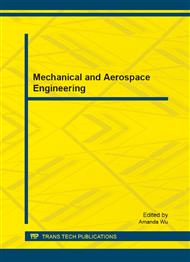p.205
p.213
p.218
p.223
p.228
p.234
p.240
p.246
p.252
Investigation of Transient Shock Wave in Supersonic Wind Tunnel
Abstract:
Wind tunnels are the experimental apparatuses which provide an airstream flowing under controlled conditions so that interesting items in aerospace engineering such as pressure and velocity can be tested. In this work, Shock wave passes through the intermittent blow-down wind tunnel at Mach=2,3,4 has been investigated. The shape of the nozzle contour for a given Mach number was determined using the method of characteristics. For this purpose MATLAB code was developed and this code was verified with Osher’s and AUSM methods, FORTRAN code and FLUENT software was used for these two methods, respectively. Dimensions of different parts of wind tunnel are determined and minimum pressure ratio for the starting condition has been founded using FLUENT software. Good agreement was considered compared with the data from eleven tunnels over their range of Mach number.
Info:
Periodical:
Pages:
228-233
Citation:
Online since:
November 2012
Price:
Сopyright:
© 2012 Trans Tech Publications Ltd. All Rights Reserved
Share:
Citation:


